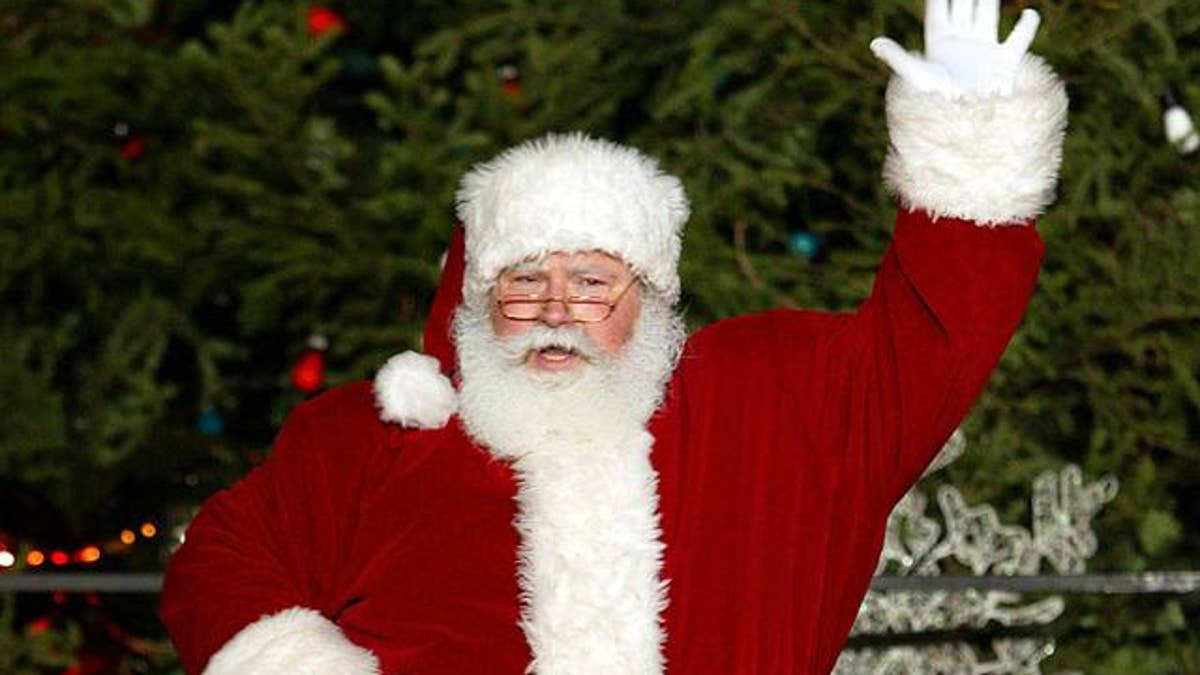
Santa Claus waves during the 91st annual city Christmas tree lighting ceremony at the Daley Plaza in Chicago on Friday, Nov. 26, 2004.(AP Photo/Nam Y. Huh)
In the movie classic "Miracle on 34th Street" a very precocious little girl named Susan Walker is sure there is no such thing as Santa Claus.
In the well-known 1897 letter to the New York Sun newspaper, 8-year-old Virginia O'Hanlon wonders the same thing, and asks the editor, because if the answer to her question appears in the newspaper, then she knows it must be true.
While parents grapple with how to explain to children the once-a-year appearance of a man dressed in a red suit, there is a historical and practical explanation.
Yes, Susan... Yes, Virginia... there is a Santa.
Although skeptics abound, the spirit of every Santa Claus is rooted in a real saint; St. Nicholas, a third-century bishop in the Byzantine Empire, or modern-day Turkey. The relics of some of his bones rest in New York's Greek Orthodox Cathedral.
"He was known as a giver of gifts, but he gave them secretly," says Father Mark Arey, of the Greek Orthodox Archdiocese.
"He redeemed people from slavery, but he did it secretly. He gave dowry's to women, but he gave them secretly. He helped the poor, but secretly, never to embarrass anyone or glorify anyone but to glorify God."
The stories go that St. Nicholas also dropped coins through windows, some landing in children's shoes or stockings hung out to dry.
As Christianity spread throughout Europe, so did the celebration of feast days to saints, like Nicholas, the patron saint of seafarers, the poor and children.
But it's a long and winding road to get from the real St. Nicholas to the Santa Claus we know today.
Gregg Allison, a professor of Christian theology says, "Let's fast forward to the low countries of Belgium, The Netherlands and Luxembourg, and we have St. Nicholas becoming Sinter Claus (A Dutch translation of St. Nicholas or Sint Nikolaas). Transparently you can hear Santa Claus. And Sinter Klaus is associated with generosity and gift-giving of people of the low countries."
But then comes one of the great schisms of Christianity, the Protestant Reformation, forbidding the veneration of the saints...Including St. Nicholas, whose feast day is December 6.
Paul Vischer, creator of "Veggie Tales" and the DVD "Buck Denver Asks...Why Do We Call It Christmas?" says, "The Dutch said 'forget it' we are still going to do it. The English said 'why don't we move it to Christmas Eve and say we are waiting for Father Christmas instead of St. Nicholas. The Germans said, 'okay, we will move it to Christmas Eve, but we are saying we are waiting for the Christ Child."
'Christ Child' in German is 'Christ Kindle'.
As the Germans, Dutch, English and more came to America, each brought their Christmas traditions. 'Christ Kindle' became Chris Kringle. Father Christmas became a popular figure thanks to Charles Dickens' book, "A Christmas Carol," in which the Father Christmas character appeared as the Ghost of Christmas Present. And 'Sinter Klaus' became the dominant moniker in this conglomeration of cultures.
Vischer says, "We made sausage out of holiday traditions and came up with the American Christmas.
All these traditions seem to become unified starting in the early 1820s with the release of a poem by Clement Clarke Moore, about a mysterious winter's night visitor.
The poem begins... "Twas the night before Christmas and all through the house, not a creature was stirring, not even a mouse."
"The Night Before Christmas" helped define the Santa image in America; of the eight reindeer and a sleigh, of a chubby, bearded man in a red suit with white trim. Later, Madison Avenue got a hold of Santa. The Coca-Cola Santa became a classic illustration.
Today countless movies and ads, plus a heavily commercialized Christmas season for retailers' profits, perpetuate the Santa imagery.
But it's a bit of a distance from the original Santa.
Arey says, "For Orthodox Christians and, I think, for Christians in general, the idea of gifts associated with Christmas comes from the greatest gift, the gift of God's Son to the human family. And St. Nicholas becomes part of that, in a sense fused into that sense of giving."
Vischer says it's okay for Christians to incorporate Santa Claus into their celebration of Christmas, as long as the real Santa is acknowledged.
"I want my kids to celebrate St. Nicholas. He felt Jesus' love so heavily that he wanted to share that with every kid he met. That's the original Santa Claus."
Click to read Part One: "The Back Story: The Christmas Tree"

